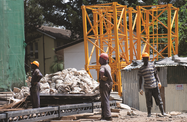Rising demand for industrial space in Kenya is shoring up the non-residential component of the country’s real estate sector, at a time when the office and retail segments appear to be moderating after recent increases in supply.

According to a study released by property consultancy Knight Frank in April, Kenya’s industrial property market has gathered strength in the past two years, with rents for prime industrial space up by 11.9% since the beginning of 2015.
“Industrial rents have risen, as a result of a move by developers into the high-end logistics market,” said Ben Woodhams, managing director for Knight Frank Kenya, at the report’s launch.
A separate analysis by commercial property services company Broll Kenya, also issued in April, said a shortage of grade A warehousing space at a time of high demand was creating new opportunities for developers – conditions that, it concluded, would continue to push up rents by 8-10%.
Rising investment
The country’s real estate industry has become central to its growth story, comprising 9% of GDP, and has matured greatly recently, having ranked among the top-10 improvers in transparency in a 2014 report by property consultancy JLL.
A broader range of investments has resulted, with the sector launching its first real estate investment trust in late 2015, and drawing private equity from the likes of the UK’s Actis, which invested in the Garden City Mall and Nairobi Business Park in the capital city.
As an investment, over the past five years property in Kenya has outperformed traditional asset classes, generating average returns of 25%, compared to 10% in other categories, according to Cytonn Real Estate, a local property investment and development firm.
Ins and outs
Occupancy rates in popular industrial areas around Nairobi have reached almost 90%, Broll Kenya said, though the figure was lower in locations where infrastructure and amenities were less well developed or roads were known to have traffic problems.
It also noted that some non-manufacturing tenants have decided to move from industrial areas to less-congested sites on the capital’s outskirts that offered better access to logistics.
Meanwhile, constraints on land acquisition have kept real estate prices high, driving many developers to look to satellite towns outside main urban areas to build more price-competitive offerings. In the seven years to 2015, land prices increased more than five-fold, according to local real estate firm Hass Consult.
In prime urban areas this trend is even stronger, with the per-acre price in Nairobi’s Upper Hill rising from KSh470m ($4.5m) in early 2015 to KSh511m ($5m) in March 2016.
Supply increase in retail
In contrast, a rapid rise in available retail space in recent months has already boosted supply across the segment, which has weighed on earnings, though activity has also risen.
According to Knight Frank Africa, retail space in Nairobi currently stands at almost 500,000 sq metres, of which more than one-quarter was added in the past 18 months alone. The increase means that, measured by gross leaseable area, Kenya is now the second-biggest retail market in sub-Saharan Africa, behind South Africa.
The wealth of choice available to retailers has resulted in two years of flat leasing costs in Nairobi, despite rising consumer demand and the arrival of new players in the market, according to Knight Frank.
Rental returns look likely to remain stagnant for the remainder of 2017 and beyond, based on current levels of supply. This could be good news for tenants when they come to negotiate deals on space, especially in older malls, where owners will be keen to maintain high occupancy and footfall in the face of rising competition.
However, industry estimates predict much of the supply will be soaked up in the coming three years, with demand supporting higher returns on investment thereafter.
Office segment
High supply has had an even greater impact in the office segment, where rental costs for grade A space have fallen by up to 20% in the past two years. About 300,000 sq metres became available in 2016, twice the recent annual average.
With more choices on offer, client turnover in some areas has been high as firms seize the opportunity to upgrade to better-quality premises and newer locations. However, here too an increase in take-up is expected within the next two years from both international and domestic companies.


